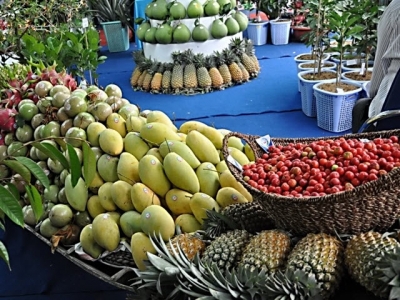Prices fall as fruit floods City markets

Ho Chi Minh City — With many fruits entering harvest season, large volumes of them have been making their way to HCM City in recent weeks, dragging their prices down.
Fruits sold at the Southern Fruit Festival being held at Suối Tiên Theme Park in HCM City’s District 9. — VNA/VNS Photo
Lychee, durian and rambutan have entered their peak harvest season.
Durians costs VNĐ50,000-VNĐ60,000 per kilo, Hòa Lộc mango type 1 costs VNĐ80,000-VNĐ90,000, and lychee costs VNĐ60,000-VNĐ80,000 if air transported and VNĐ20,000 - VNĐ35,000 if transported by road.
Trần Ngọc Lan, a fruit trader at Thị Nghè Market, said fruit prices have been falling relentlessly, and are now much cheaper than a few weeks ago.
Trần Đức Thịnh, head of the fruit section at the Bình Điền Wholesale Market, told Sài Gòn Giải Phóng newspaper large volumes of fruits have come to the market in recent days and so prices have fallen.
Co.opmart and Big C supermarkets are selling dragon fruit at VNĐ23,500 per kilogramme, lychee at VNĐ48,000, and Năm Roi grapefruit at VNĐ39,900.
Co.opmart is offering discounts on fruits as part of its “Southern fruits week”.
Around 1,000 tonnes of speciality fruits have been brought to the Southern Fruit Festival being held at Suối Tiên Theme Park in District 9, and sold at 10-15 per cent below market prices.
Ngyễn Thị Minh Anh, owner of a shop selling Central Highlands fruits in Tân Bình District, said usually for Vietnamese farm produce a bumper crop means a price fall and vice versa.
This happens every year, she said.
Experts asked why localities, when farmers are unable to sell their products, call for “rescue” efforts and why this “chorus” is repeated over and over again.
The short answer to this is that farmers grow crops without any planning.
Quality improvement
At a recent meeting HCM City held in collaboration with other localities to promote consumption of farm produce, many HCM City fruit traders said farmers do not discuss directly with them how to ensure sales of their products.
Each wholesale market in HCM City can consume up to 500 tonnes of fruit a day on peak days, meaning the city is a very good market, but the most important thing is ensuring steady supply and quality, they said.
According to fruit shops, young consumers and families with high incomes are increasingly concerned about their health, and choose to buy high-quality products regardless of their prices.
A salesperson at a shop selling imported fruits on Nguyễn Thị Minh Khai Street, District 3, said imported safe cherries, melons, and avocados costing hundreds of thousands to millions of đồng per kilogramme, or two or three times the price of similar local products, have lots of buyers.
With consumers increasingly focused on the safety of foods, farmers need to enhance the use of good farming practices, experts said.
Related news
 Dragon fruit dominates Việt Nam fruit exports
Dragon fruit dominates Việt Nam fruit exports Dragon fruit has dominated Vietnamese fruit exports in the first four months of 2018 with total exports reaching US$427 million, a year-on-year increase of 9%
 Vietnam sees potential for organic fertilizer business
Vietnam sees potential for organic fertilizer business Vietnam’s imports of organic fertiliser has surged in the past three years, reflecting increasing demand for the green product.
 Retailers, exporters active in distributing lychee
Retailers, exporters active in distributing lychee Unlike previous years when retailers and exporters only came to lychee farms in Luc Ngan district, Bac Giang at the peak of the harvest season.